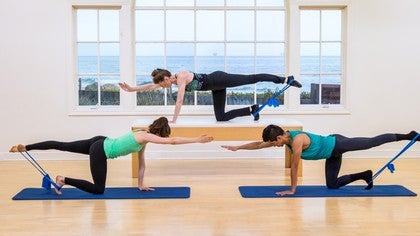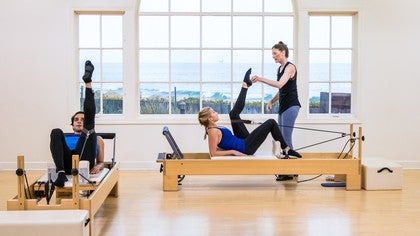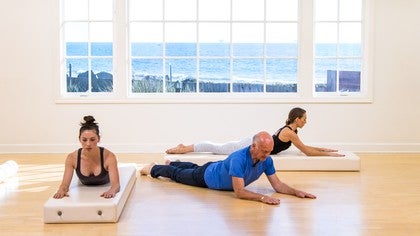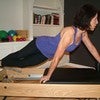Description
About This Video
Transcript
Read Full Transcript
Hi, my name is Karen Clippinger, and I'm joined today by Melody from Cal State Long Beach and Ishmael, a recent graduate from Cal State Long Beach. And we're gonna do a mat class today that's focusing a bit on alignment. So we're trying to work with the concept of symmetry in terms of the cuing that we're giving. So I'm gonna have you all stand up, and as you stand up, just to get in starting position, put your fingertips on your hip bones on the front. And from here, I want you to shift your weight from side to side and find center where your weight is equal on your right and left foot.
And then let it go to where you normally are and see if you're different from that symmetrical. I have scoliosis, and I'm always struggling with this. Some of you will probably have much smaller changes, but we're trying to work for that symmetry. And now, find that place where you're right in between, your feet equal weight on the right and the left side. And now from here, anteriorly tilt that pelvis, posteriorly tilt the pelvis, and see if you can find that neutral position where you feel it upright.
Now rib shift to the right, rib shift to the left, and find center where your ribcage is over your torso, and then let it go to where you would naturally be. And correct it again so that it's right over. And last thing, bring your chin forward and your chin back, and see if you can find that position where your head is aligned over your torso, and torso is aligned over your pelvis. And that's what I want you to try to focus on feeling as many times as you can throughout this mat, that relationship of parts and right versus left. So we're gonna start today by laying on our backs with a classic pelvic tilt exercise.
And from here, gonna inhale. And as you exhale, bring that ribcage slightly down and the pubic bone closer together. And again, inhale and exhale, and this time, let it go to its open position. And inhale, exhale. Pubic bone slightly up, ribcage slightly down, and here, press that abdominal wall out, and now pull it in towards your spine.
And feel that difference of working those deep abdominal muscles. And press the abdominal wall out, and pull it in towards your spine. Trying to feel those muscles working, curl up, taking the hands on the side of your thighs. Now you're actively gonna use those arms to help pull you up just a little bit higher. And from this position, let go and hold.
Two, three, four, and lower back down. And again, slight pelvic tilt, curling up, hands to increase that flexion. So try to feel those scapula come up the mat, rounding that spine, and from here, let go and hold. And curl back down. Again, curl, and lifting higher.
Abdominals out, and now pull 'em in as much as you can, keeping them there, arms go back, arms go forward, and lower. And curl, lifting higher, arms go back, arms go forward, trying not to drop down, and lower. Both hands on the outside of your left thigh, pulling up on the diagonal, trying to keep that right shoulder really lifted as those arms go back, and forward, and lower. Same side, lifting up, pulling up higher, and arms back, and arms forward, and lower. Other side.
Outside of the right arms, pulling up, trying to think of both sides of your pelvis staying on the mat as those arms go back and forward, so the rotation is higher up in the torso. Curling, and lifting higher, and arms back, and arms going forward, and lower down. Going into pelvic curl, articulating starting from the bottom of the pelvis, coming up to approximately straight position between knees, hips, and shoulders, and rolling back down, smooth motion. Pelvis, a little bit of thoracic extension at that top part, and lowering back down, and curling up. This time, take your fingertips to the base of the buttocks and try to lift that just a little bit higher without arching your low back, and lower back down.
And curling, thinking of knees reaching away, pressing down with your feet as you come up to this position. Taking your right leg off inline with your knee, and lowering down to touch the mat, lifting up thinking of pressing down with that left foot, and that hamstring working on that left side. And curling down, and pressing up, lifting that bottom of the pelvis, and lowering down, and lifting up. Again, lowering down, and lifting. Now, in this down position coming up onto your forearms.
And don't worry about coming all the way up, but we're just reaching that knee out using those hamstrings on that side. And lower, and two, and lower, knee reaching away, three, and lower, and four, and lower, bringing the right leg down, and curling back down. Left leg is out, and from here, lifting up, trying to feel that pressing into the ground, bottom of the pelvis lifting on the right side, and lower. And lifting, right knee reaching away as you lift higher, and lower. Two more.
Lifting up, and lower. Last one. Lifting up, and lower, coming up onto your forearms, and from here, again, not worrying about going all the way flat, but just reaching that knee away as you lift. And two, and three, and four, good. Coming back down, taking that left knee, and extending it to stretch that hamstring.
Just a gentle pressing away as if you're gonna lower that leg down. And then from here, reaching that leg and pulling it closer into your body. Now if you're less flexible, Ishmael is demonstrating. You can have your hands below your knee, the back of your thigh, or you can use a towel or a band to help bring it in. And more one time, pressing away.
Lift that hip, drop that hip, and try to feel that crease on the front of the hip. Using the hip flexors to pull the leg just a little bit closer and trying to feel that back of that thigh, relax, and bend the knee, and switch sides, bringing that right leg up. And from here, develop, extending it out, and pulling away. And if you're more flexible, then you can straighten the other leg, like Melody is showing. and really emphasize pulling that leg up nice and close to your chest, but still focusing on keeping that hip down.
So lift, and lower, and try to feel those hip flexors pull the leg just a little closer. And press away gently. And relax, trying to feel that hamstring lengthen and yield in this position. Bending that leg, bringing it down, both legs straighten, arms in this overhead position. The arms lifting up for a roll up.
Slow mo curling up, taking the scoop the first time, reaching back with those abdominals as you're reaching forward with your hands. And now from here, curling back down, vertebra by vertebra, as those arms go overhead. Now flexing the feet, and arms come up. Head up or back, feeling that sequential curl, and coming forward in this position. From here, bending your knees just a little, and pressing those heels into the floor so you feel the hamstrings, trying to feel those hamstrings on the back of the leg contract.
And then walk the right hip back, left hip back, and allow yourself to go further forward. Bend those knees just slightly, pressing down with those heels, making those hamstrings contract just gently. And then right hip back, left hip back. Try to feel those hamstrings lengthen, and see if you can go just a little further forward. From here, flexing the feet and bring your arms out to the side.
So spine twist. Working for symmetry here, so you're gonna shift from your right to your left sitz bone and find your weight where it's right in between, equal weight. Bring your left arm up, and from here, rotating away, one, and two, and come back to the center. Again, same direction, rotating right one, and two, stay there and see if you're equal still between your sitz bones. And come back to center, switching arms.
Left arm out, right arm up, and rotating side. And a little further, and come back to center. And rotating side, and a little further. Check the weight on those sitz bones. Make sure it's even.
Bring your other arm out to the side. And now reaching to the side, trying to feel the rotation in your trunk doing our classic two. And center. Little pulse going one, and two, and center. Trying to feel equal rotation to the right as you have to the left.
Staying here, thumbs going up, rotating the upper back, just a small arch, reaching back, taking those hands overhead, reaching them out to the side as you come up to center, and rotate. Other way, rotating side. Thumbs lifting up, arching that upper back. And from here, hands going overhead, keeping that lift. Arms going side, coming up to vertical, and coming back to that center position.
From here, bringing our arms back, and bending the left leg up. Lifting the right leg. So you're gonna allow your low back to flex just a little, but then add thoracic extension as you lean back. And lifting the right leg up, and bend. And now lift it closer, and extend, and come back down.
And lifting up, and again, go at your own range. Bend, lift it higher, extend, and lower down. Once more like that. Lifting up, and bend, and extend, and lower down. Three times.
Slowing lifting up, emphasize the up, and lower. And lifting up, and lower. Last one. Lifting up, and lower, bringing that right leg in, left leg out. And from here, lifting that left leg up, and bend.
Lifting it higher. And from here, extend, and come back down. And leg comes up, and bends. Trying to feel that deep iliopsoas as if you know where it is, really deep inside. And develop, and coming down.
And lifting up, and bend. Lifting higher, and extend. Coming down slow, keeping the knee straight. Coming up one, and two, and three. Good, and bend that leg back in.
Keeping your knees bent, we're gonna press down and do some little dips here. Right? So bending, and coming back. And bending, and coming back. And bend, and coming back, trying to feel those scapular depressors work.
Coming back down, reaching the legs to the front for back support. Find that upright position of you body, and just go a little forward so you're vertical. And now lean back and think of that whole back moving together as you come up, and then flexing at your hip as you come forward. So you're gonna go a little bit further forward. Yes.
And going back, trying to feel that extension at the hip, and coming forward, and going forward, and coming back, and lifting up, and down. And forward, last one, make it your best. Coming back, reaching long with that head, reaching out with those feet, lifting that bottom of the pelvis, nice long line. Good. And come down, and come forward.
Lifting your legs, bending those knees. We're gonna do single leg stretch, but starting from sitting. So I'm trying to do that to work with more range. So you're gonna curl back down. And bring the back of your waistband on, but try to keep the shoulders lifted off as much as you can.
Lift the other leg off so it's reaching out. And now from here, switching sides, pull up just a little bit more. And switching sides. And pull up just a little more. And switching sides, pull a little more.
Last one. Coming in, and pull, stay here. Stay in this lovely position, pulling those abs as much in as you can, and reach the arms side. And up, and switch, lifting just a little higher, and arms side. And up, and switch, lift just a little higher.
Trying to keep that lift as much as you can as those arms go side. And switch, last one. Lifting up, and going side. And back, bringing both legs in, and coming up to sitting position, keeping those knees bent, palms facing up. And from here, our shoulder external rotation.
Rotating out. Elbows right by your sides, pivoting as you rotate two, and three, good, and four. Now we're gonna add the upper back. So arms rotate, thumbs going back. Just a little lift in that upper back.
And extend those arms behind you, elbows in, and go front. And arms rotate, upper back lifts, and extend, elbows in, and front, and rotate, upper back, and extend, coming in and front. Once more, rotate. Now really think of the right side going back a little further. Left side going back a little further.
Find that place where it's even. Add that upper back, and now extend, pulling with both arms equally, staying there. Thumbs go back, one. Both equally, two. Again, three.
Last one, four, and come up to sitting. Taking the band under your toes, going into our rows. So I have them quite far so they're over the edges so they won't fall off. Right? And knees are almost straight or straight.
Oops. And from here, palms are facing up. And in that up position of your palms, we're gonna pull those elbows back. And bring them forward, and pull them back. And just notice, are you pulling harder with the right or the left.
We usually have a favorite side. Right? And come forward. So if you're right handed, make sure that left is pulling back as much as the right. And go forward.
And both pulling back, stay there. Pull both back a little further, and add that little arch back, and coming forward. And both coming back. And now not an arch, but just a hinge going back just a little, and come forward. Arms going forward, and pull back.
Once again, that hinge idea. Low abs, low back, lifting as you go back, and come forward. Now without the torso, just the arms are going back. Hold them in that position. Left a little further, right a little further, both pull back.
Try to feel it even. Shoulder blades slightly down and together. And bring the elbows towards the floor and back one, towards the floor and back two, and both even three. Last one, four. From here, arms forward.
Curling back down, bending those knees a little further. Back of the waist is on, and elbows are staying right by your sides as you bend one, and two, and three, and four. So biceps, but trying to work on that core stability. While you're bending, nothing is changing in that core. Good.
And coming back up to sitting. And from here, curling back down. And bend those knees a little further. And bend, and reach up with those arms. And bend, reaching up.
As you reach up, think of pulling the abdominals back so your upper back doesn't arch. Lifting up, two more, bend and lift. Last one. Bend and lift, coming to sitting. Taking the band underneath your knees.
And starting with just bringing your arms to the side, so shoulder abductors, just gently to the side as you lift up. And three, and four. Now take the band under your knees, take your hands facing forward, imagine that your arms are sliding up a wall as you go overhead, and come back. And going up two, and lower down. And three, and lower down.
And four, good, two more. Lifting up, five. Staying there on six. Lifting up six, bending the elbows, and reaching side one. Reaching side two.
Reaching side three, and four. Just two more. Five, up and side, last one. Six, and coming back down. Now we're gonna take the band behind our back.
And from here, really grip it under the armpits, and bring your arms forward. So this is trying to work that serratus anterior that brings the shoulder blades forward. And coming back. Elbows reaching down and forward as you go forward. And coming back.
Reaching down and forward, and coming back. And down and forward, good. Stay there. Shoulder blades just come together and reach down and forward. And shoulder blades, and down and forward.
Last one. Shoulder blades down and forward. And now rolling onto your stomach. Trying to ply that with pushups. So you're gonna be on your knees, and bring your pelvis down.
And from here, let those shoulder blades come together, and then separate. And together, separate. Trying to use those same muscles we just worked on. Just a mini mini pushup. Right?
So those elbows are bending side, and coming up. And bending side, and up, two more. Bending side, and up, once more. Side, and up, let those shoulder blades come together and separate. If you're stronger, Ismael's gonna demonstrate doing it from the feet.
Same idea, coming down, and coming up. And two, and up. And three, last one. Four, stay there, and come back down. Feet down for breast stroke.
Here arms are reaching overhead. And as they go side, you're arching gently. Keep it small for the first ones. Elbows bend and come down. And arms reaching side, just a little upper back.
And reaching side a little more. Elbows bend and lower. And arms, and arch, lifting up. And bend, and lower. Once more, arms, reaching up, stay there.
And right side lifts just a little higher, and come back down. Right side lifts just a little higher, and lower. As it lifts to the right, think of shifting to the right, and lower. Left side lifts up, and lower. Shifting to the left, lifting up, and lower, once more.
Shifting up, and lower, stay there. Bring the arms overhead. Mini swimming. Right arm up, left leg up, and then switching sides. Just a very small motion, trying to feel those low abdominals co-contracting as your back is working.
Taking the band in. And from here, going back to my favorite, rest position. And here, focus on those low abs still pulling in and lengthening that lumbar spine. So the coccyx is reaching towards the floor. Bringing the toes underneath.
Going up into upstretch position. And when you're in this upstretch position, think about pressing that chest through as those sitz bones reach towards the ceiling. And now, bending the knees, and coming forward to front support. Going past your hands a bit so that it's really challenging to hold. And now from here, lifting at the hip, and bringing those heels back down towards the floor.
Once again, knees bend, and coming forward past your hands. Pelvis nice and low, trying to find that thoracic extension in this position. One more. Upstretch, reaching the heels down. Bending the knees, coming forward, and the knees touch the ground, as you go down onto your forearms.
And from here, lifting up so you're arching that upper back. And letting it rest for just a minute. And lifting up, really arching, head, upper back. Stay there, and reach the right arm out. Bring it back down, and lower.
Again, symmetry, think about both sides of your back lifting when you're in this position. Rock to the right hip, left hip, and try to stay in the middle. As you reach that arm out, way up, way up, way up, way up, way up. Good, arm comes down, and relax. Once more, lifting up.
And reaching that arm out, and up. Way up high. Lifting back, reaching back on that diagonal. Bring it in, and lower. And lifting up.
A-S-I-S are off the floor, reaching out, lifting up. Reaching back on that diagonal, elbow in, and lower. Other side, lifting up. Left arm reaches out and up. Try to feel equal weight on both sides, elbow in, and lower.
A-S-I-S lifting, rock right left, find center, and reach out. Elbow, and lower. Once more, lifting up, reaching out. Lifting higher, and come back down. Adding the rotation, lifting up.
Arm reaches out, it reaches back behind you, elbow in. And lower, last one, reaching up, elbow out. Reaching back, way back, good, and coming forward. Coming up to cat for just a moment. Lifting up into that cat position.
And coming back just to neutral. And try to feel the difference. Lift with your upper back and now lower, and see if you can feel like a hand on your low back. That you're rounding into that position as you lift up and then lower back down. Switching and tying the band above the knees.
So right above those thighs. And we're gonna go into some rotation. So I want you to think about this rotation occurring from your hips, right, rather than from your knee and down. So laying back on your elbows, bringing the legs to the side. And here, externally rotate from the hip, and now come back to parallel.
And externally rotate starting from the top of the hip, knee, and then foot, and bring the legs further to the side. Come back in and go parallel. And externally rotate. And reach those legs keeping the turnout as you go further side. Come back in and parallel.
Once more, reaching side. Externally rotate, and reaching further, coming back in and parallel. Now internal rotation. So legs are side. Now right here, rotate out, and rotate in, a foreign feeling for many of us.
And rotate out, really try to feel that internal rotation. And rotate out, keep it internally rotated, and bring your legs to the side in that internally rotated position. Keep them internally rotated as they come back and then parallel. And legs side, internally rotate, go a little further. You're really trying to feel that gluteus medius on the front working there.
The side of the hips here come in and parallel. Once more. Side, internally rotate, going further out, and coming back in. Coming back onto our elbows, and bringing that right knee up to your chest. And develop, and bend, and touch.
And again, if you're less flexible, don't worry about fully straightening the leg. And bend, and lower, and that knee comes up, and extends. And bend, and lower, again. Lifting up, and extend, and bend, and lower. Other side, lifting up, and extend, and bend.
And lifting up, and extend, and bend, and lifting up, and extend, last one. Lifting up, and extend, now stay here. Right foot touches down, left touches down. Trying to keep your pelvis even, not rocking from side to side, as you stabilize and bring one leg down, and then the other leg down. Good.
And one down, and other leg down. Bringing both legs up in this position. And from here, coming back down. Rocking so that your weight is on your left hip. Taking your hand and putting it right on that left knee.
And now you're gonna bring the right side of your pelvis back to the mat, and then come back again. So you're thinking of the A-S-I-S, the top of the pelvis going back towards the mat and returning. Again, going back towards that mat and returning as if you had a hand under your pelvis that you'd be squishing it, and coming back. So we're trying to do rotation of the pelvis rather than the upper trunk. And now switch sides.
Rock onto your right hip. Hold your right knee where it is, and bringing that left A-S-I-S back and forward. And bringing it back, and coming forward, and bringing it back. And coming forward once more, bringing it back, and coming forward. Now bringing the right leg down, left leg down.
Straightening your legs and rolling on your side to face me. From here, lifting the top leg up in parallel position, and come back down. So really try to find that parallel where you're not externally rotating and lower down. And again, lifting up, and lower down, and lifting up. And now remember what we talked about of that rotation from the hips.
You're gonna externally rotate both legs, lift the leg up, little toe back, keep that turnout as you lift higher, and come back down. And lifting the leg up, reaching the toe back, rotate from that hip as you go up higher, and lower down. Again, lift, and back, and rotate, lifting higher, and lower down. Last one, lifting up, and back, rotate, lifting higher, and come back down. Now internally rotating and bringing that top leg to the front, but trying to not let the pelvis come with it.
So think of your pelvis still being stacked, and your toe is facing down. You're lifting with the heel, internally rotated as you lift up. And two, and three, good, and four. And now from there, taking that leg parallel, and lifting the bottom leg up. And lower, keeping that top leg still as you lift the bottom leg up.
And lifting it up, and lower, and lifting it up, and lower. And now keeping that bottom leg lifted slightly, just small side kicks. Little flex to the front. And reach, allowing yourself to shift on that arm a little. And flexing to the front, and reaching to the back, and flexing to the front, good, and reaching to the back.
Last one, flexing to the front, and reaching to the back. From here, taking both knees and bending them, and think about rocking back like you're rocking back about a third of the way. And you're gonna curl up on that diagonal, come back down and touch your shoulder blade. If you're not strong enough, take your fingertips to help lift up, and lower back down. Or use your elbow to help you lift up, and lower down.
And lifting up coming just a little higher right here, find that place where you can hold, and now lift the legs up and lower, and two, lifting up, and lower, and three, lifting up, good, and four, right from there, scooting to the edge of your mat towards the front of your mat, and rolling. Gonna rock from hip to hip. Try to feel that place where you're in the middle. And I want you to think of one arc going from the middle of your sacrum to the base of your spine. And you're gonna roll on that and come back up.
And again, rolling right down the center, and coming up. Two more. Rolling down and up. Last one. Increase that posterior tilt as you go back and as you come forward.
Taking your legs around so that you can lay on your other side facing towards me. And arm overhead, starting with that parallel position, lifting up one, and lower down, and two, and lower, and three, and lower. Once more, four, and lower. Externally rotate both legs. Lift that leg up, little toe back, and reaching up higher, and lower down.
Back to parallel, lifting up, rotate, little toe back. Lifting higher and back down. And lifting up, turned out, little back, and reaching higher, and lower. Last one. Lifting up, little toe back, reaching higher, and down.
Turning that leg in, reaching it forward, and lifting up one. Touching that toe, and two. Good, and three. Trying to feel that rotation from the hip, and four, coming down. And lifting the bottom, the top leg staying where it is to lift the bottom leg to meet it up one.
And meet it two. And lifting up three. Once more, and four. Keeping that bottom leg lifted just slightly, and coming forward, and reaching back, allowing yourself to shift your weight forward and back just a little. And reaching back, and coming forward, and reaching back, and coming forward.
Last one, and reaching back, and bending your knees, and bringing them up so that you're rolling about a third of the way back. And from here, curling up on that diagonal. Coming down just a touch the shoulder blade, and coming up, and lowering down. And coming up, good, and lower down. Last one, staying there, find that place where you can balance, and now scoop the legs to lift them up.
And scoop, so think of a posterior tilt, bringing that pubic bone up as your legs lift. And lifting up, good. Bring both legs into your chest for just a moment. And now, rolling onto all fours, taking the band around your feet to go into our back leg lifts. So we're gonna start with the right leg going back.
Make sure the left toes are under to keep the band from sliding off. Reaching that leg back along the floor, keeping the knee where it is as the heel comes higher. Lifting from the back of the knee. And extend, reaching up to the ceiling and come back down. And sliding, and bending that knee, and lifting higher, and extend, and come back down.
Now right here, reaching the left arm out. Sliding the right leg back, and lift that leg, bend the knee, lifting just a little higher. And extend, and come back down. And reaching out, and bend the knee, and lifting it higher, and extend. Keep it there, keep it there, externally rotate.
Lift the leg up a little, a little higher, a little higher. Last one, and bring it in. Other side, toes under, sliding that leg back. Trying to feel equal weight on your right and your left hand. And from here, bending that knee, lift that knee higher, and extend, and come back down, and riding back, right here, bend the knee, and lift it higher, and extend, and come back down.
And now reaching the opposite arm out, sliding that leg back, and bend, and lift higher, and extend, and lower it in. And going back, and bend, lift higher, and extend. Stay there, externally rotate, and lift that leg just a little higher, and just a little higher, and just a little higher, and a little more, good, and come back in. Bringing your feet so that they are facing the front. Taking that band and bringing it out to the edge of your toes.
And we're gonna start by separating the feet quite widely, and lean back a little bit for this. Little toes are going out, and coming back. So knees are facing up to the ceiling. You're really trying to isolate it to the ankle and the foot. Little toes are going out.
Hold that position just a little, and come in, and going out, and hold that position, and coming in once more. Going out, hold, and come back in. Now we're gonna add rotation. Little toes go out, and the legs rotate, and come back in. Little toes out, rotating from the top of the hip, further, and come back in.
And little toes out, rotate trying to keep equal weight on your right and your left hands. And little toes out, and rotate, coming back in. Bending the right foot up so that it's close to your knee. And this time sitting more vertical. And take this other band that's on your far foot, and spread it so it's right at the edge of the toes or going past those toes.
And here, reaching the toes away from each other and coming back. So these are the muscles, right, really important for preventing shin splints and rolling in. Really trying to get those nice and strong. And pulling in, feeling that up and in with your feet. Good, and going out, two more.
Up and in with the feet, and going out. And up and in, and coming out. And switch sides, making sure that once you get it in place that it is out far on the bottom foot. And bring yourself to a more vertical position from here. Toes going away and in and going away.
That's it, nice and coming back. A scoop, like you're scooping out the inside of a bowl. And back so the foot is staying pointed as that inner arch is lifting. And going out, and coming back once more. Going out and coming back, bringing the right foot up making sure that band is right at the edge of the toes, and here you're going to lean back so your hip flexers can relax for a minute.
Bring your lower leg so it's close to parallel to the ground, that's it, and now from here were going to pull the toes and top of the foot back and then away, and toes and top of the foot back. Good, and really control that return. And coming up, and control the return. And coming up, and control the return, now lifting with that inner board of the foot and coming back to neutral. And lifting with that inner board of the foot, good.
And coming back to neutral. Lifting with the outside and coming up. And outside of that foot, coming up. Coming to a more vertical position, bringing your knee so that it's just slightly bent. And from here extending, one and two and three, reaching that toe up towards the ceiling--four, two more, five, last one, six, and switching sides.
Flexing that foot, leaning back. And from here, thinking of that second toe being in line with the shin for the first four. And lifting up, pulling the top of the foot closer to your shin, really getting that full range. Control the return, and lifting up, and a little bit higher, good, and return, and lifting up, and a little bit higher, and return. Inner part of the foot, leading as it comes up.
And again, big toe, inner part of the arch leading as you come up, and now switch, little toe and outside of the foot leading. Last one, little toe outside of the foot leading. Coming up to a more vertical position allowing your knee to straighten more, and from here extend, and two, and three, and four, and five, last one, and six, and bring that leg back down. Bringing your legs to the side. So side bend starting from the knees and facing towards me.
Starting from your knees, hand facing away, and just lifting up and over, and come back down. And again, up and over, we'll take the version where the head comes down, and lower. And up and over, now right here, bring your bottom forward, so your pelvis is forward, so you're in a more straight line with your knees, that's good. And lower down, and your bottom goes back here. But as you lift, I want you to try and feel that it's coming in line with your body as you come forward.
Last one, up here, stay there, and from here just bring your top foot front and your other leg back and reach up and over here, now come down just a touch and right back up to that position. Up and over, and come down to touch. Last one, up and over, feel that pelvis under you, come down and switch to the other side. Starting with the knees bent, fingertips away, and coming up, and back down. And coming up, and back down.
Now try to feel as you come up here bring that pelvis forward so it's more in line, good. And now lower down, and coming up, pelvis is in line, and lower, this time we're gonna stay up. Coming up, stay there, bring your top leg front, other leg here, try to feel that position, your pelvis froward, now come down just a touch, and back up and over, and just touch, and up and over. Really try to feel that pelvis under you. Reaching up for the ceiling, obliques working, obliques working, obliques working, good, and come back down, going on to your elbows.
Little exercise in working on changing course ability right from position to position. And so we're bending our knees, lifting our pelvis from this position, and from here you're gonna rock on your side. Your arm's gonna come up, and then you're gonna rock so you're straight down, and rock on the other side. And your arm is coming up, and you go to straight down. And rock, and over, and rock, and over, and rock, and over, and rock, good, and over, from here coming back onto your hunches for just a minute, and now lifting up and bringing the left leg forward for hip flexer stretch.
And starting with your fingers on the floor, reaching up, trying to bring that bottom of the pelvis forward. If it's comfortable for your knee, coming up with your hands on your knee, thinking of pulling that ASIS back. And up on the back leg, and now reaching you arm overhead. From here, lift up just a small. Lift up and back, trying to feel that arch, that nice arch, and coming forward.
Switching sides, bringing the left knee back, right leg forward, and again starting with the hands on the floor, trying to feel that bottom of the back leg coming towards the floor. If it doesn't hurt your knees, coming up. And feel that stability, that balance of pressing down with your front leg and having that knee for support. And lifting your arm up, keeping that balance, keeping that stability, think of lifting the ASIS up, and back while you're still very stable with those front legs providing the support. And slowly come up and shift.
Do one last stretch for those hip abductors to sitting with your bottom leg parallel, you leg across, and pulling it across, rotating towards that side. Allow yourself to slump back and now lift up at the base of the spine, trying to feel that lift under your ribs, behind your ears, feeling that nice vertical position. Press away with your knee into your arm. And relax, and bring it just little closer. And one more time, press away, and as you bring it closer, think of your spine growing taller, taller, taller, that's it.
And now switching sides, and rotating, allowing yourself to slump, feeling that position, and now lifting from the base of that spine, lifting nice and tall as you rotate. And pressing out with your knee. And relax, and as you let it pull in, think of growing even taller, and twisting just a little bit more. And last time, pressing away, and relax. And as you come in, trying to feel more lift of that spine.
Untwisting, coming up to standing, and ending where we started, taking your fingertips on your hip bones, right? And first, shift your weight from right to left and find that center place where your weight's even between your right and your left foot. And now go back to where you would go, and hopefully the shift isn't as far as in the beginning of the class, right? And here, coming back to that center, and rotate your pelvis forward, and the other side forward. Back and forth, and find center.
And again let it go and hopefully if it's not perfectly symmetrical, it's a little bit more symmetrical. And to early tilt, and find that neutral position. Rib shift left, rib shift right, and find neutral where you're right in between. Good, try to feel those shoulders right above your hips. Chin going forward, chin going back, lifting behind the ear.
Checking feet, ribs, shoulders, trying to feel one line of connection. Dropping your arms, trying to still feel that inner sense of symmetrical alignment. And thank you all for joining us today. We hope that we'll add a little more symmetry and alignment into your Pilates routine, thank you.
Pilates for Dancers: Clean Up Your Technique
Comments
You need to be a subscriber to post a comment.
Please Log In or Create an Account to start your free trial.







































